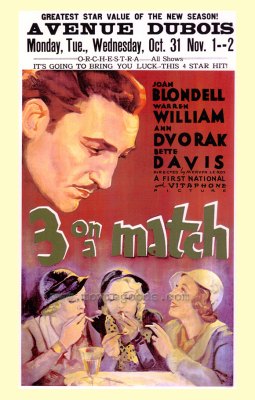1932: Three On A Match
Three On A Match (LeRoy, 1932) 6/10
 In her autobiography, Bette Davis referred to it as “a dull B picture,” while the New York Times called it “tedious and distasteful.” Yet, in the seventy-five years since its initial release, Mervyn Le Roy’s Three On A Match has garnered a cult status as one of the most exploitative and controversial films of its era for its overt promiscuity, drug use and crude imagery.
In her autobiography, Bette Davis referred to it as “a dull B picture,” while the New York Times called it “tedious and distasteful.” Yet, in the seventy-five years since its initial release, Mervyn Le Roy’s Three On A Match has garnered a cult status as one of the most exploitative and controversial films of its era for its overt promiscuity, drug use and crude imagery. The film’s title is derived from a superstition popularly believed to have existed during the First World War, but in actuality devised by a post-war Swedish industrialist to sell more matches. According to the myth, if three soldiers lit their respective cigarettes from the same single match, then one of the three would die. This idea is neatly incorporated into LeRoy’s diminutive 64 minute film, when three distant friends decide to share a match during their reunion.
Featuring a cast including a slew of then-unknown actors who later became stars, the film centers around the evolving friendship between three women from childhood to adulthood. After going their separate paths following elementary school, the group unexpectedly re-unites at a New York restaurant and begins to discuss their divergent lives.
Over lunch both Mary (Joan Blondell), a former juvenile delinquent turned showgirl and Ruth (Bette Davis), an academically gifted, but underprivileged woman forced to work as a stenographer enviously pine for the life of the popular and wealthy Vivian (Ann Dvorak). Married to prominent lawyer Robert Kirkwood (Warren William) and having a small child (Buster Phelps), Vivian appears to have it all: money, security and family.
Unbeknownst to both Mary and Ruth, Vivian is also crushingly bored by her existence. Unsatisfied by her marriage, Vivian plans an unaccompanied trip to Europe with her husband’s consent in the hope that the break will rekindle her interest. However, prior to departing for Cherbourg, Vivian falls heavily for a slick Manhattan playboy (Lyle Talbot) during an evening party. Disembarking with her young son, Vivian takes flight from her husband and enters into a destructive world of sex, gangsters, narcotics and alcoholism.
Barely running sixty-four minutes long, Three On A Match is a deliriously trashy boudoir of cinematic sin. Featuring a cast including Joan Blondell, Ann Dvorak, Bette Davis and Humphrey Bogart, Three On A Match is a wicked parable on the transformative effects of time. Utilizing stock footage and recurring glances at timepieces, the subject of time is expressly recounted throughout LeRoy’s film. Newspaper headlines become dualistic devices: escorting the viewer to the major events of the period, but also as examples to metaphorically describe the changing socio-cultural ideas affecting the film’s protagonists.
In locating his protagonists within a rapidly modifying environment, LeRoy is able to establish the internal alterations within the personalities of his characters. No more so than in the film’s central character Vivian, who is initially, presented as a “goody-two shoes,” but is subtly revealed to have a repressed sexual element: a fact evident in her nightly surreptitious perusals of tawdry, sexually explicit novels at boarding school.
The ability to change from good-to-bad and vice-versa is at the cornerstone of LeRoy’s film: enabling Vivian to regress into a drunken wastrel, whilst allowing Mary to develop from a reform school brat into a successful, good-hearted woman. In contrast to the female characters in George Cukor's The Women released seven years later, the women in Three On A Match display a complex range of emotions that are genuine in their content and intricacy. Nevertheless in strictly emphasizing the opposing paths undertaken by Mary and Vivian, the character of Ruth suffers immensely and quickly becomes an overlooked and undeveloped figure.
In connection to Bette Davis’ wasted performance, LeRoy’s film also suffers from one its principal thematic attributes: time. Packed into a sixty-four minute framework, LeRoy’s film offers scant breathing space in its clutter of visual aides memoire that dominate the film’s first half. In contrast to its stolid build-up, the film’s second portion is a frenzied, scandalous affair.
Exploiting its pre-Code conditions, the latter stages of Three On A Match contain a cavalcade of illicit ideas and brazen images including child neglect, cocaine use, extramarital affairs, kidnapping, extortion and an otherworldly suicide. It is in these moments that Dvorak and Bogart, as an unrepentant gangster, demonstrate their talent. The former’s spiraling descent from jaded socialite to a ghostlike addict is particularly riveting; the latter in his first thuggish role snarls and seethes his way to the forefront in a small performance that includes a particularly memorable swipe at Dvorak’s addictions and a scaly reaction to her son’s pleas for her to be left unharmed.
Featuring a wealth of controversial material, Three On A Match is a raw and audacious "B" picture. Filled with a trio of strong performanaces (Blondell, Bogart, Dvorak), Three On A Match exhibited Mervyn LeRoy's ability to create gritty contemporary pictures with minimal refinements or pleasantries. Although nowhere near as consistent as his best films (Little Caesar and I Am A Fugitive On A Chain Gang also released in 1932) Three On A Match is still an enjoyable and riveting picture more than three quarters of a century after its initial release.
* Three On A Match is available on DVD exclusively through Warner Home Video's TCM Archives: Forbidden Hollywood Collection Vol. 2
Copyright 2008 8½ Cinematheque

<< Home